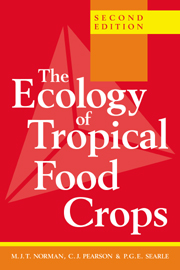1 - Tropical cropping systems
Published online by Cambridge University Press: 05 June 2012
Summary
Introduction
Food crop systems are communities of plants which are managed to obtain food, profit, satisfaction or, most commonly, a combination of these goals. Conway (1987) encapsulated the goals in the term ‘increased social value’. Such systems are purposeful in that farmers (who are part of the system) can set goals and change them even when their atmospheric, soil, technical, economic or social environment may not be changing (Bawden & Ison, 1992). Purposefulness also implies that farmers may pursue the same goals by following different behaviour patterns, either in the same or in different environments. Thus, although the market and physical environments are major constraints on the type of food crops grown, and cause farmers in a specific locality to grow similar mixes of crops, the management of any particular crop — its environment as modified by the farmer — will depend on the goals of that farmer. Figure 1.1 describes a root-crop-based farming system to illustrate the interrelationships between the purpose for which a system is managed and its human, market and physical components.
The individual crop is influenced by the system of which the crop is a component. Thus, the ecological conditions under which an individual crop is grown are determined not only by its atmospheric environment and soil, and the modifications made to this environment by the farmer — through ploughing, weeding, irrigating, applying fertiliser, cutting leaves for livestock, etc. — but also by the preceding crop, particularly if it was a legume.
- Type
- Chapter
- Information
- The Ecology of Tropical Food Crops , pp. 3 - 20Publisher: Cambridge University PressPrint publication year: 1995



